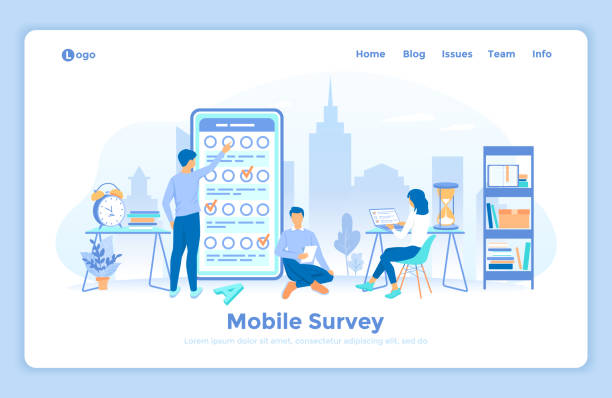An Introduction to Responsive Web Design and Its Necessity

In today’s world, where technology is rapidly changing and evolving, accessing the internet through various devices such as smartphones, tablets, laptops, and desktop computers has become commonplace.
Therefore, #responsive_design or #Responsive_Web_Design has become an indispensable necessity for every website.
This design approach ensures that your website is displayed correctly and provides a flawless user experience, regardless of the screen size or type of device the user is using.
The main goal of implementing responsive web design is for the layout, images, and content of the site to automatically adjust to the screen dimensions.
This adaptability allows users to easily access their desired content without the need for zooming or horizontal scrolling.
Before the advent of responsive design, developers had to create separate versions of a website for different devices, which was costly, time-consuming, and difficult to maintain.
However, with the introduction of responsive design principles, these problems were largely resolved.
This method not only increases efficiency but also significantly helps with SEO by improving #device_compatibility, as search engines prefer websites that provide a good mobile user experience.
Understanding these principles and their correct implementation is vital for the survival and success of any online business in the digital age.
This explanatory and educational section will help you become familiar with the basics of responsive web design and understand its importance.
This way, your website will be accessible and user-friendly on any platform.
Did you know that customers’ first impression of your company is your website? Multiply your business’s credibility with a powerful corporate website from Rasawwb!
✅ Custom and eye-catching design tailored to your brand
✅ Improve user experience and increase customer attraction
⚡ Get a free consultation!
Why Responsive Design is Crucial Today

In the current era, where mobile internet has become an inseparable part of daily life, the number of internet users via smartphones and tablets is increasingly growing.
This paradigm shift has unprecedentedly increased the importance of responsive web design.
A website that does not perform and look well on different devices quickly loses its users.
Statistics show that a high percentage of internet searches and online purchases are made via mobile devices.
Therefore, if your website cannot provide an optimal user experience on these platforms, you will miss out on significant opportunities.
In addition to user experience, search engines like Google also strongly emphasize Mobile-First Indexing.
This means that Google primarily examines the mobile version of your website for ranking and indexing.
Websites that do not have responsive design or provide a poor mobile experience will rank lower in search results, leading to a decrease in organic traffic.
Responsive web design is not just an option, but a necessity for maintaining competitiveness in the digital market.
This analytical approach shows how neglecting this principle can harm a business’s credibility and revenue.
Loss of potential customers, reduced conversion rates, and damage to the brand are all negative consequences of ignoring responsive design.
Technical Principles of Responsive Design and Its Tools

Implementing responsive web design requires a deep understanding of several key technical principles.
The most important of these principles include Media Queries, Fluid Grids, and Flexible Images.
Media Queries allow the browser to apply different CSS styles based on device characteristics such as screen width, height, orientation, and resolution.
This technique forms the backbone of responsive design and allows the site layout to change based on screen size.
For example, you can define that on smaller screens, columns are stacked vertically instead of being displayed side-by-side.
Fluid grids use relative units like percentages (%) instead of fixed pixel units (px) for element widths.
This makes the site layout automatically adapt to the screen size.
Flexible images also use CSS to adjust their width so they do not overflow their container while maintaining their aspect ratio.
This prevents images from being cropped or becoming too large on small screens.
Tools like Bootstrap and Foundation are powerful CSS frameworks that significantly simplify the responsive web design implementation process by providing a set of responsive components and grids.
Learning these principles and mastering the use of these tools is essential for any web developer.
This specialized and educational section provides the technical foundations needed to build a responsive website.
| Technical Principle | Description | Application in Responsive Design |
|---|---|---|
| Media Queries | CSS rules applied based on device characteristics. | Changing layout, font, and styles for different screen sizes. |
| Fluid Grids | Using relative units (percentages) for element widths. | Creating layouts that automatically adjust to screen width. |
| Flexible Images | Images with a maximum width of 100% and auto height. | Ensuring correct display of images on any screen size without overflow. |
Content Optimization Solutions in Responsive Design

Simply having a responsive layout is not enough for success; content optimization also plays a vital role in providing a flawless user experience.
In responsive web design, content must not only be easily viewable on different screen sizes but also be presented in a way that is meaningful and accessible to users on any device.
One of the most important aspects is image optimization.
Using high-resolution images on desktop devices can be great, but on mobile, it leads to slow loading and high data consumption.
The solution is to use responsive images that, using attributes like srcset and sizes in HTML, enable the browser to select the best image version based on the user’s device.
Also, managing videos in a responsive environment is important.
Videos should be embedded in a way that their width is proportional to their container size and, at the same time, maintain their aspect ratio.
This is usually done using CSS to maintain a 16:9 or 4:3 aspect ratio.
Text also needs to be optimized; font size, line height, and letter spacing should be readable on different devices.
Using scalable fonts and setting appropriate breakpoints for changing font sizes can help with readability.
This guiding and specialized section helps you optimize your site’s content to provide the best experience on any device, because an excellent responsive web design is incomplete without optimized content.
Is your online sales not as expected? With Rasawwb, solve the problem of low sales and poor user experience forever!
✅ Increase visitor to customer conversion rate
✅ Create an enjoyable user experience and increase customer trust
⚡ Act now for a free consultation!
User Experience and Responsive Design: Integration for Success

In the competitive world of the web, responsive web design is more than just a technical change; this approach directly impacts User Experience (UX).
A strong and positive user experience keeps users satisfied, increases their time spent on the site, and ultimately leads to higher conversion rates.
Responsive design ensures that users on any device enjoy a consistent and high-quality experience.
This consistency in experience builds a sense of trust and professionalism.
Imagine a user who visits your site via mobile and is forced to scroll horizontally or zoom in to read content; this negative experience will quickly cause them to leave the site and search among your competitors.
Furthermore, mobile UX must be specifically designed, as interaction patterns on mobile differ from desktop.
For example, using a finger for touch and scrolling requires larger buttons and links and sufficient space between elements.
Also, page load time is crucial on mobile devices, as mobile users usually have more unstable internet connections.
A responsive website with fast loading directly contributes to a better UX. This explanatory and analytical section shows how attention to UX details alongside responsive web design can lead to a website’s lasting success.
The importance of this combination is undeniable in today’s world.
Popular Frameworks and Tools in Responsive Design

To facilitate the responsive web design process, numerous tools and frameworks have been developed that help developers build devices-compatible websites with greater speed and efficiency.
These frameworks provide a set of pre-defined codes, styles, and scripts that can be used as a basis for new projects.
One of the most popular and well-known frameworks is Bootstrap.
Bootstrap is a powerful front-end framework that includes a responsive grid system, pre-built UI components (like buttons, forms, navigations), and JavaScript plugins.
Using Bootstrap, responsive layouts can be quickly created, ensuring their compatibility across different browsers.
Another popular framework is Foundation.
Foundation is also an advanced front-end framework that offers similar features to Bootstrap, but with a greater focus on flexibility and customizability.
In addition to these major frameworks, there are other tools that assist in responsive web design.
For example, Flexbox and CSS Grid are two powerful CSS modules that give developers unprecedented control over element layouts and are ideal for building complex and responsive layouts.
This guiding and educational section helps you choose the right tools for your web design projects and accelerates the process of building responsive websites.
Common Challenges and Solutions in Responsive Design

With all its numerous benefits, implementing responsive web design is not without its challenges.
One of the most common challenges is Performance Management.
Responsive websites can contain large images, heavy scripts, and numerous CSS styles, all of which can increase page load time, especially on mobile devices with slower internet connections.
Solutions to this challenge include image optimization (compression, using modern formats like WebP, and Lazy Loading), minifying CSS and JavaScript, and leveraging a CDN (Content Delivery Network).
Another challenge is managing complex content or data tables that don’t naturally display well on small screens.
For tables, various approaches can be used, such as horizontal scrolling, hiding less important columns on small screens, or converting the table into separate cards on mobile.
Also, Navigation can be challenging on mobile devices.
Common solutions include using Hamburger Menus or Dropdown Menus that take up little space while providing access to all parts of the site.
Statistics and news show that many websites are still struggling with these challenges.
By being aware of these issues and implementing appropriate solutions, a stable and efficient responsive web design can be achieved.
| Challenge | Problem Description | Solution |
|---|---|---|
| Performance | Long loading times due to heavy resources. | Image optimization, code minification, use of CDN. |
| Complex Tables | Improper display of tables on small screens. | Horizontal scrolling, converting to cards, hiding columns. |
| Mobile Navigation | Limited space for navigation menus. | Hamburger menus, dropdown menus, sticky navigation. |
The Future of Responsive Design and Emerging Trends

Responsive web design has evolved over the years and continues to advance.
With the emergence of new technologies and changing user expectations, the future of responsive design will also undergo changes.
One important trend is Progressive Web Apps (PWAs), which seek to combine the best features of web and native applications.
PWAs can work offline, send notifications, and provide a native-app-like user experience, while still being built on the web and adhering to responsive principles.
This technology can fundamentally change how users interact with websites.
Another trend is a greater focus on Google’s Core Web Vitals, which evaluate metrics such as loading speed, interactivity, and visual stability.
These metrics directly impact SEO rankings and encourage developers to prioritize performance optimization.
Also, Adaptive Design, where multiple fixed layouts are created for specific screen sizes, may be used alongside responsive design to provide more control over layout at specific breakpoints.
Will responsive web design move towards full automation? This question will be further explored in future analytical and thought-provoking content.
But it is clear that this path is full of innovation and change.
Research shows that 80% of customers trust companies with professional websites more. Does your current website inspire this trust?
With Rasawwb’s corporate website design services, solve the problem of customer distrust and poor online image forever!
✅ Create a professional image and increase customer trust
✅ Attract more sales leads and grow your business
⚡ Get a free consultation!
Impact of Responsive Design on SEO and Website Performance

The importance of responsive web design extends beyond mere visual appeal and user experience; this approach directly impacts Search Engine Optimization (SEO) and overall website performance.
Since 2015, Google officially announced that it prefers mobile-friendly websites in its search results.
This means that a website with responsive design is more likely to appear higher in Google’s rankings for mobile searches.
As a significant portion of internet traffic comes from mobile devices, this SEO advantage is highly valuable.
Furthermore, having a single codebase for all devices instead of separate versions simplifies website maintenance and updates.
This leads to fewer errors and improved site efficiency.
Search engines also prefer responsive websites due to the ease of crawling and indexing a single URL for all devices.
Page load speed, which is an important factor in SEO and user experience, also improves with a proper responsive web design.
Responsive websites minimize loading times by optimizing resources for each device.
This specialized and explanatory section shows you how investing in responsive web design directly contributes to improving your site’s visibility in search engines and, consequently, increasing your business’s traffic and success.
Conclusion: A Bright Outlook for Responsive Design

In conclusion, responsive web design is no longer just a trend, but an industry standard and a vital requirement for a successful presence in the web space.
From the continuous increase in mobile users to the growing emphasis of search engines on mobile user experience, all evidence indicates that the future of the web belongs to websites that can dynamically adapt to any device.
Investing in a responsive web design means investing in the accessibility, efficiency, and long-term sustainability of your business.
This approach not only improves user experience and increases conversion rates but also helps your website gain more visibility in search results by optimizing SEO.
Challenges such as performance management and complex content are also solvable with existing technical solutions.
Given emerging trends like PWAs and the focus on Core Web Vitals, it can be expected that responsive web design will continue to remain at the center of web developers’ attention and be further enhanced by new technologies.
Remember that a responsive website is not only ready for your today, but also equipped for the challenges and opportunities of tomorrow. This engaging and informative conclusion highlights the importance of continued attention to this area by presenting a clear outlook.
Frequently Asked Questions
| Question | Answer |
|---|---|
| What is responsive web design? | It is a web design method that ensures websites display well and are usable across various screen sizes (mobile, tablet, desktop). |
| Why is responsive design important? | Due to the increasing use of various devices with different screen sizes (such as mobile and tablet) by users to access websites. |
| What are the main technologies used in responsive design? | It uses techniques such as Media Queries in CSS, Flexible Grids, and Flexible Images. |
| What are the benefits of responsive design? | Provides a better user experience across all devices, improves site SEO, reduces maintenance costs (compared to having a separate site for mobile). |
| Is responsive design necessary for all websites? | Mostly yes, as it ensures your site is accessible and functional for a wide range of users and the devices they use. |
And other services of RasaWeb Advertising Agency in the field of advertising
Smart Link Building: A specialized service for digital branding growth based on key page optimization.
Smart Google Ads: Designed for businesses seeking to increase website traffic through custom programming.
Smart Link Building: A combination of creativity and technology to improve SEO ranking through SEO-driven content strategy.
Smart Advertising Campaign: A fast and efficient solution for digital branding focusing on attractive UI design.
Smart Link Building: A specialized service for user engagement growth based on key page optimization.
And over hundreds of other services in internet advertising, advertising consulting, and organizational solutions
Internet Advertising | Advertising Strategy | Advertorial
Resources
- Comprehensive Guide to Responsive Web Design
- Media Queries in Responsive Design – MDN
- Why Responsive Design is Crucial for Your Business?
- Future Trends in Responsive Web Design
✅
? To elevate your business in the digital world and reach the top, Rasaweb Afarin, a specialist in digital marketing services including corporate website design, is your professional partner.
📍 Tehran, Mirdamad Street, next to Bank Markazi, Kazeroon Janoubi Alley, Ramin Alley, No. 6


